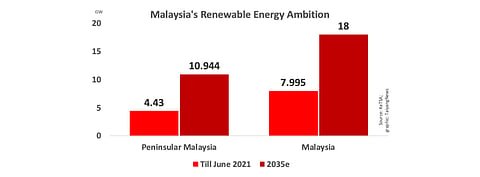

As part of its energy transition plans for 2040, Malaysia is aiming to have 31% of its total electricity mix being contributed by renewable energy by 2025. It will then be scaled up to 40% in 2035, according to the Ministry of Energy and Natural Resources (KeTSA). Previously, the government had a target of 20% renewable energy share by to be achieved by 2025.
During a meeting of ASEAN Ministers of Energy on June 21, 2021, Malaysian Energy Minister Dr. Shamsul Anuar bin Haji Nasarah said to date the installed renewable energy capacity of Malaysia has reached 7.995 GW, and by 2035 the country aims more than double it to 18 GW.
Of the 31% renewable energy target for 2025, Peninsular Malaysia is to account for 26%, and out of 40% target for 2035, Peninsular Malaysia is to add 32% of the total. High in solar potential, Peninsular Malaysia is to increase its renewable energy capacity from currently 4.43 GW to 10.944 GW by 2035. The ministry also plans to introduce utility scale battery energy storage systems (BESS) with a total capacity of 500 MW from 2030 to 2034, to support solar power generation.
According to the minister, power purchase agreements (PPA) for more than 7 GW of coal power plants will expire by 2033 and replaced mostly by gas and renewable energy which will help the country meet its Nationally Determined Contributions (NDC) targets under the Paris Climate Agreement to bring down its carbon emission intensity from power sector by 45% in 2030 and 60% in 2035, compared to 2005 levels.
On the future of coal in the country, a statement by KeTSA emphasized, "Although Malaysia will not be building new coal power plants, the Ministry does not discount the option of extending the operation of these plants. However, the decision for extension of these plants will depend on future availability of technologies in reducing emissions and also the cost of adopting those technologies."
Commenting on this clarity on the country's energy transition plans, Skrine law firm of Malaysia, according to Mondaq, said it remains to be seen if solar energy will still remain an attractive prospect to industry players in the future, and also if the government will consider other renewable resources as hydrogen and wind power.
In March 2021, analysts at Fitch Solutions Country Risk & Industry Research offered an upward revision of Malaysia's installed solar power capacity to grow from around 996 MW at the end of 2020 to exceed 4 GW by 2030 (see Fitch Solutions Expects 4 GW Solar Capacity For Malaysia).
Malaysia has been holding solar energy auctions for utility scale segment which has been generating good interest from developers and bringing down cost of solar power generation. In the large scale solar (LSS) tender round 4, the Malaysian Energy Commission attracted RM 0.1768 per kWh as the lowest winning bid, down from RM 0.178 per kWh determined in LSS3 round (see RM 0.1768/kWh Lowest Bid For Malaysia's LSS4 Round).
.png?w=50&fm=png)